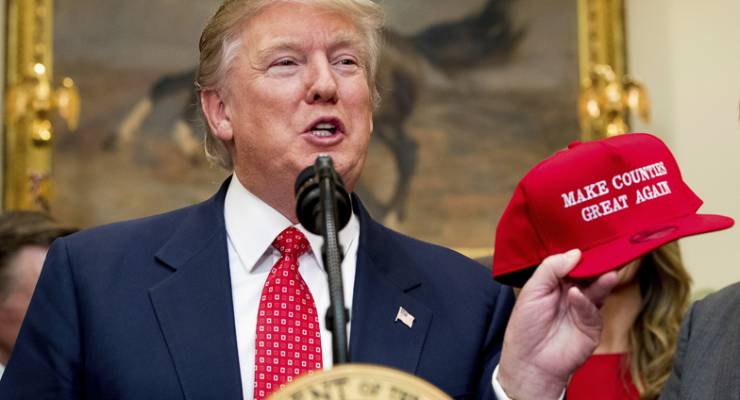
The wheels are not yet falling off the US economy, but a few nuts are certainly loose. Yes, it’s early days still. But four and a half months after team Trump’s first budget, there are disturbing rattles.
Federal debt
Those watching US government debt got a bit of a shock yesterday when the debt added on Friday was posted: an increase of $41.2 billion. In one day. That brings the September total to $400.4 billion. That’s more debt added in one month than the entire debt of Greece. It’s more than the annual gross domestic product of Norway or Egypt or Austria.
In comparative US terms, that’s the second highest monthly increment since the depths of the Great Recession in 2008. Yet these are days of booming global trade and record corporate profits. And, according to Trump tweets, “the best economic numbers in years”.
Employment
The jobless rate has continued in a straight line downwards over the last eight years. From a peak of 10.0% in October 2009, it fell to a 16-year low of 4.3% in May this year. Since then it has fluctuated between 4.3% and 4.4%. It has not dropped below 4.0% as expected — as happened in the late Bill Clinton years. Of greater concern is average weekly hours, which declined by 0.1 hour through August to 34.4 hours. Hours so far through 2017 have averaged 34.4, almost exactly the same as 2016. This is down, however, from the averages of 34.51 in 2014 and 2015. Given global conditions, this is an audible knock in the transmission.
Personal savings and debt
Savings by Americans across the economy have collapsed dramatically this year, continuing a slide that began in 2016. From $844.4 billion in the second quarter (Q2) of 2015, this fell to $745.2 in Q2 2016. It has tumbled to $545.6 in this year’s Q2.
Simultaneously, personal interest payments broke the $300 billion barrier the June quarter to $300.7 billion. That compares with $276.3 in the same quarter last year and just $267.6 in 2015.
New home sales
Sales of new single-family houses fell in August to a seasonally adjusted annual rate of 560,000. That’s well down from the average for the first six months of 2017 of 610,000 and below 567,000 in August last year.
Tourism and trade
These both indicate how a country is travelling as an international citizen. Both have slumped since Trump’s inauguration despite the global boom.
The average trade deficit for the seven months January to July was negative $45,585 million. Last time it was this low was in early 2012, near the end of the global financial crisis. Averages have been $42,066 million for all 2016, $41,704 million for 2015 and $40,861 million for 2014.
Tourists to the US have grown impressively since the GFC ended in 2013. Total travel and tourism-related revenue rose 7.9% in 2014 to $140,419 million. It rose in 2015 by 5.7%, followed by an impressive 7.1% lift in 2016.
The trend since Trump’s election has been dismal, although statistics here are not as current as some. The latest data is for April this year which shows tourist arrivals from Mexico between January and April are down 4.9% on the same period last year to 5,395,374. Now, why could that possibly be?
Total tourist arrivals from the rest of the world, excluding Canada and Mexico, are down 4.3% to 10,378,442.
Still looks healthy enough, but this is another wobble in the suspension.
Value of the US dollar
Shortly before Donald Trump’s inauguration in January, the US dollar was equivalent to 96 euro cents. It is now down to 85.1, a decline of 11.4% in eight months. It has declined 8.1% in value relative to the UK pound. It has even declined relative to the Aussie dollar, the only major currency to do so.
Consumer confidence
At 95.1 index points in September this is well below the January peak of 98.5. It has been downhill most of the way, except for a surge in August, which did not last.
Shift in the tax burden
Trump is copying Australia in shifting the tax burden from companies to workers. Company taxes collected in the first half of 2017 were up just 2.0% on the same period last year, whereas taxes on personal income increased 3.9%. Hence the proportion of the total tax derived from companies has declined to 12.1%. The average for the last five years is 13.3%. This is despite booming corporate profits, and warnings against such a dopey tax strategy.
Growth
The US economy grew at an annualised rate of 1.2% in the first quarter of 2017 and a healthier 3.1% in the second, for an annualised rate currently of 2.2%. Not bad, but it remains well below par, ranking only 25th among the 35 rich developed countries comprising the Organisation for Economic Co-operation and Development.
Watching brief
Assessing these again after a full year will give a truer picture of the triumphs or tribulations of Trump’s team. But it is fair to say, at this stage, that the tallies do not live up to the tweets.








NEWS FLASH: Monday’s total debt added was $102.9 billion!
In one day.
That’s more than the entire national debt of Iraq!
https://www.treasurydirect.gov/govt/reports/pd/pd_debttothepenny.htm
Just like the LNP are better economic managers than Labor, the US is the great bastion of successful commercialism.
Meanwhile, in other news… reality bites.
America’s economic success is now Fake – since its failure in Vietnam onwards and it’s bloated military its been increasingly insolvent. The US defeated the USSR by outspending it and didn’t learn the lesson of its victory. The question is what will be the US’s reaction if it’s debtors call in their chips? There’s just so many weapon sales and wars that can keep you going and the public distracted by Faux Fox News.